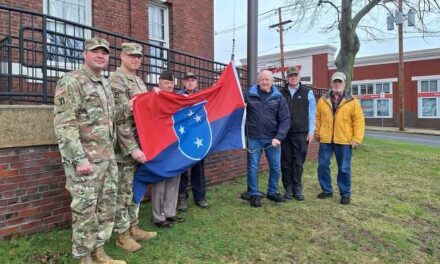By BOB BURGESS
WAKEFIELD — This is ridiculous.
While the town won’t see as much snow as originally forecast, snow totals from January 24 increased by the foot over the weekend, today and into tomorrow, schools were canceled, ice dams strengthened in frigid temperatures, arms-length icicles dangled from gutters, many commuters stayed home, businesses were shut and the winter of 2014-15 dragged on in what was supposed to be a three day storm.
By the end of today, the town will have seen about 76 inches of snow fall this winter, all but about nine inches of it coming in the last two weeks.
“There’s really no place to put more snow,” said DPW Director Richard Stinson, a sentiment shared by many residents and commercial property owners.
Stinson is asking the town for another $400,000 to deal with costs of these most recent storms.
In a Feb. 3 memo to Town Administrator Stephen P. Maio, the Board of Selectmen and the Finance Committee requesting the overdraft in the snow and ice removal account, Stinson writes, “This winter season has been amazing. Long periods with no snow and 10 days of record snowfall. Dealing with extreme weather events in all seasons has become a common occurrence for public works.
“Normally I will request an overdraft with mostly details, however, the past 10 days requires that I let you know what an outstanding job the public works staff and our contractors have done to keep Wakefield streets safe and passable. During this 10 day period we have responded to five events, performed one hauling event, cleared corners, cleared sidewalks and cleared town buildings. On January 23 there was no snow on the ground. As of February 2, we have received 54 inches of snow and two of those storms have deposited 29 inches and 16 inches of snow respectively. It is important to note that the past five years average snow fall is 62 inches from November through March, meaning we have received close to an average winter’s snowfall in a 10 day period.
“This group (Public works) of committed and dedicated public servants has worked as much as 163 hours during this 10 day period. During the snow storm of January 26th thru January 28th, some staff worked as much as 48 hours straight. They have had little rest, no days off and have sacrificed their families for the benefit of Wakefield. They take their jobs as emergency first responders seriously and are committed to making sure Wakefield is safe for residents and visitors. They are the ‘Silent Arm of Public Safety.’
“Snow and Ice operations require that all 10 public works divisions (all staff) participate to insure that we have roads, schools, town buildings, and parking lots cleared and useable as quickly and efficiently as possible. Then once completed these dedicated staff go home and clear their driveways after working in extremely difficult and tiring conditions. When they return to work after a storm, they go back to working on heating systems, building maintenance, tree issues, pot holes, water/sewer station maintenance, cemetery burials and many other projects and activities to insure that our infrastructure is maintained and continues to operate effectively. There is no downtime.
“I want to commend the Public Works staff and our contractors for the amazing and outstanding job they have done during the past 10 days. I cannot think of a better group of professionals to be associated with.
“Finally, I want to thank the Wakefield Police Department for their assistance during our snow removal and sidewalk clearing efforts which insures that these operations are safe,” Stinson said.
This morning, the DPW director said, “This has been long and tiring for everyone. We were originally supposed to get between 18 and 24 inches from Sunday into Tuesday. But the storm has shifted to the south a little. We thought it was going to be worse.”
From midnight to about 6 a.m. today, Stinson said Wakefield received about two inches of snow, when much more was forecasted. The storm is supposed to wind down around 6 p.m. today, rather than sometime tomorrow morning.
The first DPW crews reported to work midnight Saturday (into Sunday), and all snow removal personnel both town and private were in by about 2:30 a.m. yesterday. Everyone was sent home between 8 and 8:30 last night.
Stinson said around 8:45 a.m. today that the town had received a total of about eight inches between then and when the storm started yesterday.
All parking on town streets is prohibited until 10 a.m. tomorrow.
The selectmen were originally scheduled to hear Stinson’s overdraft request at their meeting tonight, but because of the snow they will meet Wednesday instead.
In the request, Stinson wrote, “As of February 3, 2015 we have expended in excess of the snow & ice appropriation of $650,000. As you know from our budget presentation, the cost of an average winter is estimated at $1,138,980 to clear in excess of 550 roads which represent 105 miles and 250 lane miles.
“To date, the department has responded to 14 storm events of which six have required plowing operations. Additionally, we have performed one full hauling operation, cleaned corners, and cleared snow from various locations around town. The amount of snow received to date is 63.5 inches.”
If not needed the funds will not be expended and will not impact the fiscal year 2016 tax rate.
—————
Here’s how the latest snowstorm is ravaging our region again:
BESIEGED UNTIL EARLY TUESDAY
Some areas of Massachusetts had about a foot of snow before dawn, and the storm was expected to last all day Monday. The weather service reported an unofficial measurement of almost 14 inches in Norwell as of 5 a.m. Monday. Fitchburg, Leominster, Lunenburg and Ashby in north-central Massachusetts were all at 11 inches or more. Logan Airport in Boston had eight inches, and the city was forecast to get as much as 2 feet by the time the storm tapers off early Tuesday.
‘PRETTY MUCH UNPRECEDENTED’
In Massachusetts alone since last month’s blizzard struck, state workers have removed enough snow to fill Gillette Stadium 90 times over, Gov. Charlie Baker told reporters Monday morning, calling the situation “pretty much unprecedented.”
It’s the third major snowstorm in nearly two weeks, and parts of Massachusetts have already seen over 60 inches of snowfall, Baker said, warning it would cause challenges for the state.
Baker ordered nonemergency state employees to stay at home.
MORE TRANSIT HEADACHES
Boston’s Logan International Airport was allowing only a limited amount of flights to arrive and depart Monday. Travelers were urged to check with their airlines.
Boston’s transit system, the nation’s oldest, has been particularly hard hit this winter. The buildup of snow and ice on trolley tracks combined with aging equipment has stalled trains, delaying and angering commuters. On Monday, nearly 50 commuters were rescued from a Massachusetts Bay Transportation Authority train that became disabled between stations in Quincy, just south of Boston.
The snow caused some problems for workweek commuters as the speed limit on the Massachusetts Turnpike was reduced to 40 mph along the entire length of the highway, and in New Hampshire, speeds were reduced to 45 mph on the highways.
DEEP FREEZE COMPLICATIONS
Adding insult to injury, the Massachusetts Emergency Management Agency warned that potentially record-low temperatures and wind chills are expected to move into the region later in the week.
Baker said state offices would be closed for nonemergency personnel Monday, and he encouraged businesses to allow employees to work from home or stay home so they wouldn’t be on the roads.
WHERE TO PUT IT ALL?
In many New England communities, the obvious problem is where to put the new snow.
David Lombari, public works director for West Warwick, Rhode Island, said his town was already clogged with piles of snow several feet high and school buses were parked in the usual snow storage lot.
“I don’t know what we’re going to do yet,” Lombari said. “It’s tough trying to find a place that meets all the proper (environmental) criteria.”
—————
Associated Press radio correspondent Julie Walker in New York City and AP writers Philip Marcelo, William J. Kole and Mark Pratt in Boston and Mary Esch in Albany, New York, contributed to this report.
State snow disposal guidelines require that communities use locations that won’t harm environmental resources and have barriers that prevent contaminants from seeping into groundwater when the snow melts. In Massachusetts, officials were using giant melters to liquefy the latest snow.
FOUR MEN AND A JEEP
Carrie Sullivan, a manager at Uncle Charlie’s Finer Diner in Weymouth, said she needed four men and a Jeep to dislodge her car from piles of snow in her driveway early Monday. When she finally got to work two hours later, the diner was filled with plow drivers and electric company crews.
“They were pretty much walking around like zombies. They’ve been working for 20 hours straight,” she said.
“I think we’d all like to get a little bit back to normal,” she said. “For now, we’ll just keep bringing the coffee and the hot pancakes.”




